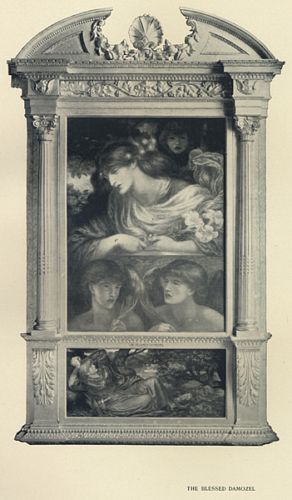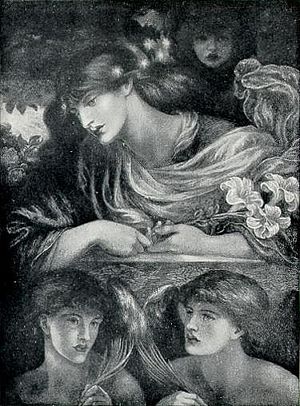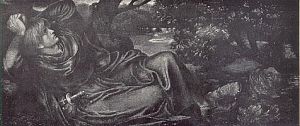The Blessed Damozel (reduced replica)
Dante Gabriel Rossetti
1875-9
Physical Description
Medium: oil
Dimensions: 59 1/2 x 31 1/2 in.
Frame: The picture and predella are set in an elaborate baroque gold frame.
Production Description
Production Date: 1875-9
Exhibition History: B.F.A.C., 1883 (no.72); New Gallery 1897 (no.63); Paris,
Franco-British Exhibition, 1908 (no.91); Port Sunlight 1948 (no. 171); Paris 1972 (no.221); R.A., 1973; Rotterdam-Paris 1976 (no.206)
Patron: F. R. Leyland
Date Commissioned: 1880
Original Cost: £500
Note: Leyland bought the picture “in lieu of a
Hero
commissioned some years previously and never executed, for which 800 gns. had been
paid” (
Surtees
, vol. 1, 144 [no. 244.r.1]). WMR says he bought it in late 1880, but he did not take
possession until February 1881 (see Doughty and Wahl's Letters, vol. IV, 1842-46, and WMR's
DGR as Designer and Writer, 110-11).
Model: Alexa Wilding
Provenance
Current Location: Lady Lever Art Gallery, Port Sunlight
Catalog Number: WHL4391
Archival History: F.R. Leyland; Christie's sale May 28, 1892 (lot 55), £1,029 to the Honorable Mrs. O'Brien (later Lady Inchiquin); The Lady
Lever Art Gallery
Sources of the Work
Literary Source:
Iconologia, Filippo Pistrucci, 1821
Note: This Aldine book was in the library of DGR's father, and its illustrations of
emparadised female lovers clearly inspired DGR. WMR says that this book made a great
influence on DGR, in particular its “coloured allegorical designs” (
Family Letters, vol. 1, 62) of women.
Literary Source:
La Vita Nuova, Dante Alighieri, 1292
Note: Beatrice figure
Myth: vision of paradise
Culture: Christian
Geographical Scene: Broadlands
Other Information: It is said that the beechwoods in the predella were painted near Broadlands, the home
of the Cowper-Temples. But the report is contradicted by the fact that DGR left
Broadlands in 1876, never to return; and the predella was done in 1878 (Surtees,
A Catalogue Raisonné, 142 and
n.).










Scholarly Commentary
Introduction
The Blessed Damozel is probably Rossetti's most famous painting. It is certainly his most elaborate presentation of the subject that interested him beyond all others: the relation of an emparadised woman to her earthly lover. The pictorial version of the subject comprises a later commentary or visual interpretation of the poem by the same title that Rossetti had written much earlier, in 1847. The subject is also at the heart of his great translation project that culminated in his collection of stil novisti verse, The Early Italian Poets .
This picture is the second of the two fully elaborated versions of the work. In its central features it replicates the original version. It differs in some notable ways from the first version, however, not least in the baroque frame (not by DGR) which so detracts from this painting. The removal of the paradise of kissing lovers reduces the formal complexity of the work and perhaps its conceptual range as well.
Production History
The picture was begun shortly after the more famous version bought by Graham, but this replica remained unsold until 1881. DGR was still working on it in April 1879 (Doughty and Wahl, Letters, vol. III, 1453, vol IV, 1632).
Iconographic
The iconography of the original painting is replicated in this one, except that here the erotics of the damozel's paradise are muted by the replacement of the kissing lovers by the child–angels.
Bibliography